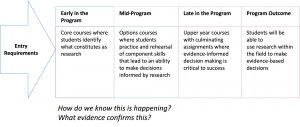8 Progression of Learning: Capturing Teaching, Learning, and Assessments across the Academic Program
‘Progression of Learning’ describes the increasing levels of difficulty and complexity in acquiring knowledge, skills and attitudes. It implies that learning is a process of increasing difficulty and complexity over time (e.g. the length of one’s academic studies), rather than a body of content to be covered (UNESCO International Bureau of Education).
Section 5 should give readers an overall sense as to how your students progress through the program, ultimately achieving the end-state of being able to perform the intended learning outcomes. Often, this includes noting the ‘checkpoints’ where progress is assessed. For example, when a graduate student passes their comprehensive exams, it is affirmed that they are progressing effectively through significant components of the program.
Section 5.1.5. invites writers to comment on progression of learning. It should be quite clear in this section how the academic program structures and measures students’ progress. However, other parts of Section 5.1 might provide additional detail that support the reader’s overall understanding of program structure.

Assessment, Especially at the End of the Program
If progression of learning leads to students who can perform the intended program learning outcomes, then upon graduation they should be able to demonstrate this ability. How can you assure readers that your graduates can demonstrate the learning you strive to promote through your program? Here are some common examples:
- capstone courses or assessments that offer students an opportunity to demonstrate their mastery
- final term course load and aspects of the teaching and assessment strategies used
- defence requirements common in graduate programs
- practicum placements, particularly toward the end of a program
- reflective components
In many cases, it is difficult to point to a singular assessment or a culminating event that offers this assessment and confirmation. In these cases, how can you provide readers enough detail about your curriculum that they are convinced that graduates are likely to reflect those intended outcomes?
Admission Requirements
Section 5.1.6 asks that writers describe the admission requirements to the program and how they are appropriately aligned with requirements of the program. This is essentially asking: How do you know that students coming into your program have the requisite knowledge and skills to be successful in their studies?
This is often interpreted in two ways:
- entry admission to the university (e.g. entry requirements for first year study)
- entry from general studies into the selected academic program of study
In Section 5.1.6., it is recommended that you outline what the entry requirements are, as you understand them and make use of them for determining who is accepted into your program and who is not. Then explicate why those requirements are what they are. What do those requirements tell you about incoming students, particularly about the knowledge, skills, and values they are beginning the program possessing?
Engaging in Curriculum Mapping
Section 5.2 asks you to engage in curriculum mapping to support you as you document and outline your programs’ progression of learning. Curriculum mapping is “the process of associating course outcomes with program‐level learning outcomes and aligning elements of courses (e.g., teaching and learning activities, assessment strategies) within a program, to ensure that it is structured in a strategic, thoughtful way that enhances student learning” (Dyjur et al., 2019, p. 4).
A curriculum map is a document that organizes a large amount of ‘curriculum data’, information about your program’s curriculum design, such as program learning outcomes, courses, and elements of those courses. Depending on it’s structure and level of detail, a curriculum map can be used to analyze:
- which courses support learning that relates to specific program outcomes
- how students progress through their learning over time
- the major forms of teaching and assessment across courses/across the program
- when/where students are introduced to concepts, skills, or values, when/where that learning is reinforced, and when/where students demonstrate mastery.
Read more in the Curriculum Mapping unit.
Reference
Dyjur, P., Grant, K., & Kalu, F. (2019). Curriculum review: Curriculum mapping. Taylor Institute for Teaching and Learning. Calgary: University of Calgary. https://taylorinstitute.ucalgary.ca/sites/default/files/Curriculum/Curriculum%20Mapping%20UPDATED%202019.pdf

